analiza naprezanja u ucvršcenju polova rotora generatora s ...
analiza naprezanja u ucvršcenju polova rotora generatora s ...
analiza naprezanja u ucvršcenju polova rotora generatora s ...
Create successful ePaper yourself
Turn your PDF publications into a flip-book with our unique Google optimized e-Paper software.
Ma{instvo 2(7), 63 – 74, (2003)<br />
N.[virig;....: ANALIZA NAPREZANJA U U^VR[^ENJU...<br />
ANALIZA NAPREZANJA U U^VR[^ENJU POLOVA<br />
ROTORA GENERATORA S ISTAKNUTIM POLOVIMA<br />
Dr.sc. Nikola [VIGIR, Fakultet elektrotehnike i ra~unarstva u Zagrebu, Sveu~ili{te u Zagrebu<br />
Doc.dr.sc. Mirko HUSNJAK, Fakultet strojarstva i brodogradnje u Zagrebu, Sveu~ili{te<br />
u Zagrebu<br />
REZIME<br />
U radu su dani rezultati eksperimentalnih istra`ivanja metodom fotoelasticimetrije rasporeda <strong>naprezanja</strong><br />
po konturi u~vr{}enja pola <strong>rotora</strong> <strong>generatora</strong> s istaknutim polovima oblika kombinacije lastin rep-~eki}<br />
i oblika tri ~eki}a. Tako|er su odre|eni kriti~ni presjeci kao i njima faktori koncentracije <strong>naprezanja</strong>.<br />
Klju~ne rije~i: generator s istaknutim polovima, u~vr{}enja <strong>polova</strong>, <strong>naprezanja</strong>,<br />
fotoelasticimetrijska metoda<br />
STRESS ANALYSIS DURING ROTOR POLES FIXING OF<br />
GENERATORS WITH SALIENT POLES<br />
Nikola [vigir, Ph.D., Faculty of Electrical Engineering and Computing, University of Zagreb<br />
Mirko Husnjak, Ph.D. Assistant Professor, Faculty of Mechanical Engineering and<br />
Shipbuilding, University of Zagreb<br />
SUMMARY<br />
This paper gives experimental results obtained by the method of stress photoelasticity along the<br />
contours of rotor poles fixing of generators with salient poles whose shape is either swallow’s tailhammer<br />
or three hammers. It also gives critical cross-sections and stress concentration factors.<br />
Key words: a generator with salient poles, poles fixing, stress, photoelasticity method<br />
1. UVOD<br />
U fazi projektiranja i konstruiranja elektri~nih strojeva<br />
javlja se niz problema kako elektri~ke tako i<br />
mehani~ke prirode koje treba uspje{no rije{iti da bi<br />
bile zadovoljene osnovne funkcije stroja. Sinkroni stroj,<br />
koji se naj~e{}e koristi kao generator izmjeni~ne<br />
struje, predstavnik je strojeva najve}ih snaga. Izvodi<br />
se prema konstrukciji <strong>rotora</strong> ili sa cilindri~nim rotorom<br />
ili pak kao stroj s istaknutim polovima.<br />
Sam pol radi se ili u kompaktnoj izvedbi ili je<br />
napravljen od limova koji su u cjelini spojeni<br />
krajnjim polnim plo~ama.<br />
Kod velikih brzohodnih strojeva zbog velike brzine<br />
vrtnje i znatnih masa namota, javljaju se i velike<br />
centrifugalne sile koje optere}uju konstrukciju<br />
<strong>generatora</strong>, a naro~ito njegov rotor. Na rotoru s<br />
istaknutim polovima dolazi do velikih <strong>naprezanja</strong><br />
naro~ito na mjestu u~vr{}enja samog pola na<br />
rotor. Korijen pola kojim se on u~vr{}uje na<br />
lan~ani prsten izvodi se u vi{e oblika, i to kao<br />
lastin rep, ~eki}, kombinacija lastin rep-~eki}, a<br />
kod ekstremno velikih centrifugalnih sila u~vr{}enje<br />
se izvodi oblika vi{estrukih ~eki}a.<br />
1. INTRODUCTION<br />
During the design stage of electrical machines a lot<br />
of problems arise. They are both electrical and<br />
mechanical and should be successfully solved in<br />
order to meet basic requirements of the machine<br />
function. A synchronous machine, which is mostly<br />
used as an a.c. generator, represents machines<br />
which are considered the most powerful. It is<br />
designed according to the rotor design or with a<br />
cylindrical rotor or as a machine with salient poles.<br />
The pole itself is produced either as a compact construction<br />
or from sheets connected with pole final plates.<br />
In large high-speed machines due to rapid speeds<br />
of rotation and considerable winding masses, big<br />
centrifugal forces occur, which load the generator<br />
construction, particularly its rotor. The rotor with<br />
salient poles suffers enormous stress particularly on<br />
the spot where the pole itself is fixed to the rotor.<br />
The root of the pole by which it is fixed to the<br />
chain ring is designed in several ways, i.e. as a<br />
swallow’s tail, a hammer, a swallow’s tail-hammer<br />
combination. When extremely large centrifugal<br />
forces are present, the fixing is carried out in the<br />
shape of multiple hammers.<br />
- 63 -
Ma{instvo 2(7), 63 – 74, (2003)<br />
N.[virig;....: ANALIZA NAPREZANJA U U^VR[^ENJU...<br />
Kao {to je ve} nagla{eno najslo`eniji dijelovi ovih<br />
konstrukcija predstavljaju mjesta u~vr{}enja na<br />
kojima je distribucija kontaktnih <strong>naprezanja</strong> na<br />
dosjednim povr{inama nepoznata. ^est je slu~aj i<br />
stati~ke neodre|enosti sklopa {to ote`ava to~no<br />
definiranje optere}enja pojedinih sklopova i<br />
onemogu}ava jednostavno provo|enje izra~una<br />
metodama nauke o ~vrsto}i.<br />
Iz tog razloga provedena je u ovom radu<br />
eksperimentalna <strong>analiza</strong> <strong>naprezanja</strong> metodom<br />
fotoelasticimetrije u korijenu pola <strong>generatora</strong> s<br />
istaknutim polovima i oblika kombinacije lastin rep-<br />
~eki} s varijacijom kuta nagiba lastinog repa i<br />
oblika tri ~eki}a kako bi se {to egzaktnije odredio<br />
raspored <strong>naprezanja</strong> du` istog i definirala vr{na<br />
<strong>naprezanja</strong> po mjestu i iznosu.<br />
As pointed out before, the most complex parts of<br />
these constructions are the spots of fixing. The<br />
contact stress distribution on contacting surfaces<br />
of these spots is unknown. Very often the<br />
assembly is not determined statically, which makes<br />
accurate definition of assembly loading rather<br />
difficult and it also prevents simple calculations by<br />
means of the science of strength.<br />
This was the reason to carry out an experimental<br />
stress analysis by means of photoelasticity method<br />
in the pole root of the generator with salient poles<br />
and in the shape of swallow’s tail-hammer with the<br />
swallow’s tail varying angle and three hammers in<br />
order to determine the stress scheme along it as<br />
accurately as possible and define peak stress<br />
according to the place and amount.<br />
2. MATERIJAL ZA IZRADU MODELA<br />
Materijal za izradu modela mora biti opti~ki osjetljiv<br />
sa {to manjim opti~kim i mehani~kim puzanjem a<br />
uz to providan i izotropan. Mora pokazivati linearnu<br />
ovisnost deformacije u naprezanju, te<br />
proporcionalnost izme|u <strong>naprezanja</strong> i reda<br />
izokroma. Budu}i se pri optere}enju manje<br />
deformiraju povoljniji su materijali ve}e krutosti.<br />
Fotoelasti~ni materijal uz to mora biti bez<br />
unutra{njih <strong>naprezanja</strong> sa svojstvom dobre<br />
obradivosti i {to manjeg vremenskog rubnog efekta.<br />
Postavljene zahtjeve najbolje ispunjavaju materijali<br />
na bazi epoksidnih smola i poliestera.<br />
U Europi se naj~e{}e koristi araldit-B s modulom<br />
elasti~nosti E = 3,1 – 3,7 GPa, fotoelasti~nom<br />
konstantom <strong>naprezanja</strong> f σ = 103 – 120 N/cm, te<br />
dopu{tenim naprezanjem σ d = 40 Mpa, kakav je<br />
kori{ten i za izradu modela u ovom radu.<br />
3. IZRADA MODELA<br />
Svi ispitivani modeli izra|eni su iz plo~e araldit-B s<br />
dopu{tenim naprezanjem σ d = 40 MPa.<br />
Budu}i da to~nost rezultata u mnogome zavisi o<br />
kvaliteti izrade modela, potrebno je model izraditi<br />
vrlo precizno i to~no. U tu svrhu najprije je (za<br />
svaki model posebno) izra|ena {ablona od pleksistakla.<br />
Obrada modela izvr{ena je tako da se {ablona<br />
nalijepi pomo}u dvostrano ljepljive trake na plo~u<br />
araldita, te zatim tra~nom pilom izre`e dio plo~e s<br />
dodatkom od nekoliko milimetara za finalnu obradu.<br />
Fina obrada izvr{ena je obodno protusmjernim<br />
glodanjem na brzohodnoj kopirnoj glodalici. Promjer<br />
prstastog glodala iznosi φ 5 mm, a broj okretaja<br />
radnog vretena n = 40000 o/min.<br />
2. MATERIAL FOR MODEL PRODUCTION<br />
The material for producing the model should be<br />
optically sensitive with as small optical and mechanical<br />
creeping as possible and at the same time it should be<br />
transparent and isotropic. It has to show linear<br />
dependence of deformity during the stress, as well as<br />
the proportionality between the stress and isochrome<br />
order. More rigid materials are more convenient since<br />
they are less prone to deformity during loading.<br />
Photoelastic material should be without internal stress<br />
and should have good treatment characteristics. It<br />
should also have as small time edge effect as possible.<br />
Materials based on epoxy resin and polyesters are<br />
considered the best for these purposes.<br />
The material mostly used in Europe is araldite-B with<br />
elasticity module E=3.1-3.7 Gpa, photoelastic stress<br />
constant f σ σ=103–120 N/cm and the permitted stress<br />
σ d = 40 MP, like the one used for producing the<br />
model described in this paper.<br />
3. MODEL PRODUCTION<br />
All the models produced are made of an araldite-B<br />
plate with the permitted stress of σσ d = 40 MP.<br />
Since the accuracy of the results depends highly<br />
on the quality of the model, the model should be<br />
produced very precisely and accurately. That is<br />
why a perspex pattern should be made for each<br />
model separately.<br />
While making the model, the pattern is first stuck by<br />
means of a two-sided sticky strip on the araldite<br />
plate and then, a part of the plate is cut by a band<br />
saw. A few millimeters should be left for further final<br />
treatment. Fine treatment is carried out by<br />
circumferential counter-directional milling on a highspeed<br />
copying milling machine. The diameter of the<br />
finger-like mill is φ5 mm, and the number of<br />
revolutions of the operating spindle n=40000 r/min.<br />
- 64 -
Ma{instvo 2(7), 63 – 74, (2003)<br />
N.[virig;....: ANALIZA NAPREZANJA U U^VR[^ENJU...<br />
Za vrijeme glodanja {ablona se oslanja na centralni<br />
zatik na radnoj plo~i glodalice. Dubina se rezanja<br />
pak regulira postepenim smanjivanjem promjera<br />
zatika. Posmak se vr{i ru~no, te je nemogu}e<br />
posti}i potpunu ravnomjernost obrade. Zbog<br />
istro{enosti glodala i vibriranja vretena glodalice u<br />
modelu su se pojavila unutra{nja <strong>naprezanja</strong> te je<br />
bilo potrebno izvr{iti finu zavr{nu obradu<br />
dugotrajnim postupkom ru~nog bru{enja pomo}u<br />
finog brusnog papira, kako bi nestala zaostala<br />
<strong>naprezanja</strong> i rubni efekt.<br />
Nakon toga u modelima su simetri~no izbu{eni<br />
provrti za optere}ivanje. Provrti su izbu{eni dovoljno<br />
daleko od mjesto u~vr{}enja <strong>polova</strong>, kako ne bi<br />
do{lo do utjecaja St. Venantovog principa.<br />
3.1 Izrada modela pola <strong>generatora</strong> s<br />
korijenom u obliku ~eki}a, kombinacije<br />
lastin rep-~eki} i lastinog repa<br />
Modeli I - IV su izra|eni iz plo~a araldita-B<br />
debljine 8 mm, na kojima je mijenjan kut nagiba<br />
dosjednih povr{ina γ, kako je prikazano sl. 3.3. i<br />
tb.3.1. Iz iste plo~e izra|en je model V (sl. 3.2.)<br />
kod kojeg je korijen pola izveden u obliku lastinog<br />
repa.<br />
3.2 Izrada modela pola <strong>generatora</strong> s<br />
korijenom u obliku tri ~eki}a<br />
Na svim modelima do sada bio je izra|en korijen<br />
pol jednostrukog oblika. Me|utim, kod ve}ih masa<br />
namota ili ve}eg broja okretaja javljaju se i ve}e<br />
centrifugalne sile koje uzrokuju <strong>naprezanja</strong> ve}a od<br />
dozvoljenih te se zato pri{lo izradi stati~ki<br />
neodre|enih nosa~a namota. U tu svrhu izra|en je<br />
model korijena pola <strong>generatora</strong> s tri ~eki}a te se<br />
ukupna centrifugalna sila raspodjeljuje na tri ~eki}a<br />
i za o~ekivati je da }e se i <strong>naprezanja</strong> po jednom<br />
~eki}u bitno smanjiti.<br />
Dimenzije pola modela VI dane su na sl. 3.4.<br />
Model je tako|er izra|en iz plo~e araldita-B debljine<br />
8 mm s dopu{tenim naprezanjem σ dop =40 MPa.<br />
During the process of milling the pattern leans<br />
against the central pin on the working panel of the<br />
milling machine. The depth of cutting is regulated by<br />
gradual reduction of the pin’s diameter. Shift is<br />
regulated manually so it is impossible to achieve<br />
uniformity in treatment. Due to the worn milling<br />
machine and the vibration of milling machine spindle<br />
internal stresses have occurred in the model. It was,<br />
therefore necessary to apply final treatment which<br />
lasted for a long time. That is why manual polishing<br />
with fine abrasive paper was required in order to<br />
eliminate stresses and edge effect.<br />
After that symmetrical bores for loading were made<br />
on models. Bores were drilled far enough from the<br />
spot of pole fixing in order to avoid St. Venant<br />
principle.<br />
3.1 Generator pole model with hammer<br />
like root, swallow’s tail-hammer shape<br />
and swallow’s tail<br />
Models I – IV are made from an araldite-B plate,<br />
whose thickness is 8 mm, and whose contact<br />
surface angle γ was changed (Fig. 3.3. and Table<br />
3.1.). Model V was produced from the same plate,<br />
(Fig. 3.2.) whose pole root was made in the<br />
shape of the swallow’s tail.<br />
3.2 Manufacture of the generator pole<br />
root model with three hammers<br />
All models produced so far have had a pole with<br />
one root only. However, when either winding masses<br />
or the number of revolutions increase, the centrifugal<br />
forces increase and they cause bigger stresses than<br />
those allowed. That was the reason why statically<br />
undefined winding carriers were made. Therefore, a<br />
generator pole model was made (model V) having<br />
three hammer-like roots. The centrifugal force is<br />
divided into three, which should decrease the stress<br />
in each hammer considerably. Pole model dimensions<br />
VI, are given in Fig. 3.4.<br />
The model is also made from an araldite-B panel<br />
(8mm thick) with the permitted stress, σσ dop =40 MP.<br />
Tabela 3. 1. Promjenljive veli~ine za modele I – IV<br />
Table 3.<br />
1. Changing values for models I – IV<br />
Model I II III IV<br />
γ, o 0 15 30 45<br />
v, mm 0 2 4,5 8,25<br />
t, mm 20 18 15,5 11,75<br />
s 1 , mm 0 0,75 1,5 2,12<br />
- 65 -
Ma{instvo 2(7), 63 – 74, (2003)<br />
N.[virig;....: ANALIZA NAPREZANJA U U^VR[^ENJU...<br />
Slika 3.1. Dimenzije modela pola <strong>generatora</strong> oblika<br />
lastin rep-~eki} za modele I – IV<br />
Figure 3.1. The model size of the pole generator<br />
swallow’s tail-hammer shape for models I – IV<br />
Slika 3.2. Dimenzije modela pola <strong>generatora</strong> oblika lastin<br />
rep, model V<br />
Figure 3.2. The model size of the pole generator<br />
swallow’s tail, model V<br />
Slika 3.3. Prikaz promjenjivih veli~ina za modele I – IV, kombinacija lastin rep-~eki}<br />
Figure 3.3. The presentation of changing values for models I – IV, swallow’s tail-hammer combination<br />
Slika 3.4. Dimenzije pola <strong>generatora</strong> s tri ~eki}a, model VI<br />
Figure 3.4. The model size of the pole generator with three hammers, model VI<br />
- 66 -
Ma{instvo 2(7), 63 – 74, (2003)<br />
N.[virig;....: ANALIZA NAPREZANJA U U^VR[^ENJU...<br />
4. ISPITIVANJE MODELA<br />
4.1 Optere}ivanje modela<br />
Kona~no obra|en model spreman je da se optereti<br />
i da se izvr{e sva potrebna mjerenja. Polo`aj<br />
to~aka na modelu odre|en je pravokutnim<br />
koordinatama ~ija se jedna os poklapa sa osi<br />
simetrije modela. Urezivanje koordinatnih osi u<br />
povr{inu modela nije mogu}e zbog pojave<br />
unutra{njih <strong>naprezanja</strong> na modelu, koja bi imala<br />
negativnu posljedicu na ispitivanje.<br />
Optere}ivanje svih modela izvr{eno je u zatvorenom<br />
okvirnom nosa~u pomo}u vijka sa trapeznim<br />
navojem.<br />
Prijenos sile na modelima izveden je pomo}u<br />
posebnih ~eljusti koje se sa vijcima pri~vrste na<br />
model, a na drugoj strani ~eljusti nalazi se<br />
simetri~no izbu{ena rupa koja se spaja s<br />
prstenastim dinamometrom pomo}u zatika.<br />
Same ~eljusti su postavljene tako da budu<br />
simetri~ne sa modelom i da se sila prenosi<br />
podjednako na sve rupe modela<br />
Svi modeli optere}ivani su u dva me|usobno<br />
okomita smjera kako bi se {to vjernije simuliralo<br />
stvarno stanje <strong>naprezanja</strong> na mjestu u~vr{}enja<br />
pola.<br />
Omjer vertikalne i horizontalne sile kojom se<br />
optere}uje model odabran je tako kod svih<br />
modela, da se dobije odnos <strong>naprezanja</strong> koji<br />
odgovara stvarnom stanju <strong>naprezanja</strong> u realnim<br />
pogonskim uvjetima.<br />
Iznosi sila F V i F H kojima su optere}ivani modeli<br />
dani su u tablici 4.1. Odabran je uvijek onaj omjer<br />
sila F V / F H koji je za razmatranje pojava u modelu<br />
najpogodniji tj. za taj omjer u modelima se<br />
pojavljuje maksimalni red izokroma. Taj se red<br />
izokroma najlak{e snima u kriti~nom presjeku,<br />
budu}i bi se kod ve}ih iznosa optere}enja<br />
maksimalni red izokroma znatno pove}ao, te bi one<br />
postale toliko guste i nejasne da se ne bi mogle<br />
vi{e razlu~ivati (brojati).<br />
4. TESTING OF THE MODEL<br />
4.1. Loading of the model<br />
When the model is finished it is ready to be loaded<br />
and submitted to all the necessary measurements.<br />
The position of points on the model is defined by<br />
rectangular coordinates. One of their axes agrees<br />
with the model symmetry axes. Cutting in axis<br />
coordinates into the model surface is not possible<br />
because inner stresses occur in the model, which<br />
would have a negative effect on testing.<br />
The loading of all models was carried out in a<br />
closed frame carrier by means of trapeze thread<br />
screw.<br />
The transmission of force on models was carried<br />
out by means of special jaws fixed by screws to<br />
the model. On the other side of the jaw there is a<br />
symmetrically drilled hole which is connected to<br />
the ring dynamometer by means of a pin.<br />
The jaws are symmetrical with the model and the<br />
force is transmitted equally to all holes of the model.<br />
All the models are loaded in two vertical<br />
directions. In that way the simulation of the real<br />
stress on the spot where the pole is fixed is very<br />
reliable.<br />
The ratio between the vertical and horizontal force<br />
by which the model is loaded is chosen for all<br />
models, i.e. the stress ratio (σ v / σ h ) = 1, which<br />
corresponds to the real arrangement of the<br />
generator pole fixing.<br />
Values of the forces F V and F H by which the model<br />
was loaded can be seen in Table 4.1. The force<br />
ratio, F V and F H was chosen so that it would give<br />
the most convenient way of considering the<br />
phenomena in the model, i.e. for that ratio the<br />
maximum order of isochrome appears in the<br />
models. This isochrome order is recorded easily in<br />
the critical cross-section, since at higher loading the<br />
number of maximum isochrome order is increased<br />
considerably. They become so dense and unclear<br />
that they cannot be distinguished (counted).<br />
Tablica 4.1. Iznosi vertikalnih F V i horizontalnih F H sila optere}enja na modele<br />
Table 4.1. Amounts of vertical and horizontal (F V and F H ) loading forces on models<br />
Model I II III IV V VI<br />
F V , N 450 450 450 450 300 1500<br />
F H , N 460 460 460 460 310 500<br />
- 67 -
Ma{instvo 2(7), 63 – 74, (2003)<br />
N.[virig;....: ANALIZA NAPREZANJA U U^VR[^ENJU...<br />
5. NAPREZANJA PO KONTURI<br />
MODELA I ODRE\IVANJE FAKTORA<br />
KONCENTRACIJE NAPREZANJA<br />
Fotoelasticimetrijska metoda je opti~ka metoda za<br />
odre|ivanje <strong>naprezanja</strong> i deformacija u tehni~kim<br />
konstrukcijama a zasniva se na piezo-opti~kom<br />
efektu tj. svojstvu materijala da u optere}enom<br />
stanju postaje opti~ki anizotropan. Fotoelasti~ni<br />
materijali su takvi materijali koji su u<br />
neoptere}enom stanju opti~ki izotropni, a kada se<br />
opterete postaju opti~ki anizotropni (dvolomni).<br />
Opti~ka anizotropnost ovisna je o veli~ini i<br />
rasporedu <strong>naprezanja</strong>, pa se mjerenjem dvoloma<br />
mo`e zaklju~iti o rasporedu <strong>naprezanja</strong> u modelu.<br />
Analiza anizotropnosti (dvoloma) vr{i se ure|ajima<br />
koji se nazivaju polariskopi. U njima koristimo<br />
polarizirano svjetlo tj. svjetlosni val ~ije titranje je<br />
na neki odre|eni na~in sre|eno i usmjereno.<br />
Sam eksperiment provodi se na slijede}i na~in. Iz<br />
ravne plo~e izre`e se model koji je geometrijski<br />
sli~an originalnom dijelu koji se ispituje.<br />
Model se postavi u polariskop a zatim se optereti i<br />
snima, ili promatra golim okom. U vidnom polju<br />
polariskopa pojavljuju se interferencijske svijetle i<br />
tamne pruge. Analizom ovih linija izokroma<br />
zaklju~uje se o rasporedu <strong>naprezanja</strong>, odnosno<br />
deformaciji modela.<br />
Opisani eksperiment odnosi se na jednostavne<br />
probleme stati~kog optere}enja racninskih modela<br />
u elasti~nom podru~ju.<br />
Snimanje izokroma vr{eno je u kru`no polariziranom<br />
svjetlu, u svjetlom i tamnom polju, uz parametre<br />
snimanja, otvor blende 11 i ekspoziciju 8 sekundi<br />
Nakon razvijanje filma i izrada fotografija na<br />
fotografskom dokument papiru, dobiveni su snimci<br />
izokroma u tamnom i svjetlom polju, za sve<br />
modele. Na slikama 5.1 .i 5.2. prikazani su snimci<br />
izokroma u svijetlom i tamnom polju za model I.<br />
Analizom snimaka izokroma za sve ispitane modele<br />
uo~ava se da se maksimalni red izokrome javlja na<br />
rubu modela gdje se glavna <strong>naprezanja</strong> pojavljuju<br />
u radijalnom i cirkularnom smjeru:<br />
Radijalno naprezanje jednako je nuli (σ 2 =0) te je<br />
cirkularno naprezanje jednako:<br />
σ<br />
N i<br />
⋅ f<br />
2<br />
= σ<br />
, N / mm (5.1)<br />
h<br />
Kako je f σ / h = konst. slijedi da }e se za<br />
maksimalni red izokrome N i max pojaviti maksimalno<br />
naprezanje:<br />
N i max<br />
⋅ fσ<br />
2<br />
σ<br />
max<br />
= , N / mm (5.2)<br />
h<br />
Nominalno naprezanje dano je relacijom (5.3):<br />
5. STRESSES ON MODEL CONTOUR<br />
AND STRESS CONCENTRATION<br />
FACTOR DEFINITION<br />
Photoelasticity method is an optical method for<br />
determining stresses and deformities in technical<br />
structures and is based on piezo-optical effect, i.e.<br />
it is based on the property of the material which,<br />
when loaded, becomes optically anisotropic.<br />
Photoelastic materials are materials which are optically<br />
isotropic when they are not loaded, and when they<br />
are loaded they become optically anisotropic (bidiffracted).<br />
Optical anisotropy depends on the size<br />
and arrangement of the stress. Therefore, by<br />
measuring bi-diffraction it is possible to conclude<br />
about stress arrangement in the model.<br />
The analysis of anisotropy (bi-diffraction) is carried<br />
out by means of devices called polariscopes. They<br />
use polarized light , i.e. light wave whose<br />
flickering is somehow stable and directed<br />
The experiment itself is carried out in the following way.<br />
A model is cut out of a flat plate and it is geometrically<br />
similar to the original part which is being tested.<br />
The model is put into the polariscope, it is loaded<br />
and then filmed or observed with the naked eye.<br />
Within the polariscope field of sight, interferential<br />
bright and dark lines appear. By analyzing these<br />
isochrome lines it is possible to conclude what the<br />
arrangement of the stresses is, i.e. what the<br />
deformity of the model is.<br />
The described experiment refers to simple<br />
problems of a plane stress in elastic area and for<br />
static loading.<br />
Recording of the isochromes was carried out in<br />
the circular polarized light, in the light and dark<br />
field, with the following parameters, i.e. diaphragm<br />
11 and exposition 11s.<br />
After that the film was developed, the photographs<br />
were made following regular photograph procedure,<br />
and the photos of isochromes were obtained in<br />
both dark and light field for all the models. Fig.<br />
5.1. and 5.2. give the isochrome photo in dark<br />
and light field for the model I.<br />
By analyzing isochrome photos for all the models<br />
examined, it can be noticed that the maximum isochrome<br />
order appears on the model edge where main stresses<br />
in radial and circular straight line are found:<br />
Radial stress equals zero (σ 2 = 0) so the circular<br />
stress is equal to:<br />
σ<br />
N i<br />
⋅ f σ<br />
2<br />
= N<br />
(5.1)<br />
h<br />
, / mm<br />
Since f σ /h = const it is evident that for maximum<br />
isochrome order N i max , maximum stress occurs:<br />
N i max<br />
fσ<br />
2<br />
σ<br />
max<br />
= , N / mm (5.2)<br />
h<br />
⋅<br />
Nominal stress is given by the relation (5.3):<br />
- 68 -
Ma{instvo 2(7), 63 – 74, (2003)<br />
N.[virig;....: ANALIZA NAPREZANJA U U^VR[^ENJU...<br />
σ = F V<br />
2<br />
n<br />
, N / mm<br />
(5.3. )<br />
A<br />
gdje je:<br />
F V , N – vla~na sila na korijen pola<br />
A, mm 2 – povr{ina presjeka vrata korijena<br />
Poznavanjem maksimalnog i nominalnog <strong>naprezanja</strong><br />
mogu se odrediti faktori koncentracije <strong>naprezanja</strong><br />
α k u opasnom presjeku (I-I, II-II, sl. 5.3) pomo}u<br />
izraza (5.1.), (5.2.) i (5.3.):<br />
σ<br />
N<br />
=<br />
max i max<br />
α<br />
k<br />
=<br />
(5.4.)<br />
σn<br />
Ni<br />
n<br />
Na dijagramima danim na slikama 5.4. do 5.9. dan<br />
je prikaz raspodjela <strong>naprezanja</strong> po konturi za sve<br />
modele.<br />
F 2<br />
σ V<br />
n<br />
= , N / mm<br />
(5.3. )<br />
A<br />
where:<br />
F v , N – tensile force on the pole root<br />
A, mm 2 – neck root cross section surface<br />
When maximum and nominal stress is known, it is<br />
possible to determine the concentration stress factors α k<br />
in the dangerous cross section (I-I, II-II, Fig. 5.3) by<br />
means of the following expressions (5.1), (5.2) and<br />
(5.3):<br />
σ<br />
N<br />
=<br />
max i max<br />
α<br />
k<br />
=<br />
(5.4.)<br />
σn<br />
Ni<br />
n<br />
In the diagrams given in figures 5.4. to 5.9., stress<br />
distribution along the contour for all the models is<br />
presented.<br />
Slika 5.1. Snimak izokroma u tamnom polju za model I<br />
Figure 5.1. Isochrome photo in dark field for model I<br />
Slika 5.2. Snimak izokroma u svjetlom polju za model I<br />
Figure 5.2. Isochrome photo in light field for model I<br />
Slika 5.3. Prikaz opasnih presjeka modela V (a), i modela I-IV (b)<br />
Figure 5.3. Presentation of dangerous cross sections of models V (a) and model (I-IV (b)<br />
- 69 -
Ma{instvo 2(7), 63 – 74, (2003)<br />
N.[virig;....: ANALIZA NAPREZANJA U U^VR[^ENJU...<br />
Dijagrami su crtani po konturi modela tako da<br />
normala na konturu predstavlja ordinatu <strong>naprezanja</strong><br />
odnosno reda izokrome.<br />
Svi dijagrami su crtani u mjerilu:<br />
- za red izokrome<br />
10 mm = 1 red izokrome<br />
- za naprezanje 10 mm = 2 ( N/mm 2 )<br />
Analiza je vr{ena za sve modele po konturi na<br />
radijusima zakrivljenja u presjecima I –I i II - II (sl.<br />
5.3).<br />
Za sve modele prema relaciji ( 5.3 ) i sl. 5.3. (<br />
presjek I – I odnosno presjek II – II),izra~unati su<br />
iznosi nominalnih <strong>naprezanja</strong> (tb. 5.1), a iznosi<br />
maksimalnih <strong>naprezanja</strong> o~itanih iz dijagrama sa sl.<br />
5.4. do 5.9. dani su u tablici 5.2.<br />
Faktori koncentracije <strong>naprezanja</strong> za modele I – VI<br />
izra~unati prema relaciji 5.4. dani su u tablici 5.3.<br />
Tablica 5.1. Iznosi nominalnih <strong>naprezanja</strong> σ n<br />
Table 5.1. Nominal stress values, σ n<br />
Diagrams have been drawn along the model<br />
contour so that the normal to the contour<br />
represents stress ordinate, i.e. isochrome order.<br />
All diagrams have been drawn in the following scale:<br />
- for isochrome order<br />
10mmm = 1 isochrome order<br />
- for 10mm stress = 2 (N/mm 2 )<br />
The analysis was carried out for all the models<br />
along the contour on roundness radius in crosssections<br />
I-I i II – II (Fig.5.3.).<br />
For all the models according to the relation (5.3) and<br />
Fig. 5.3. (cross section I – I and II – II), the amounts<br />
of nominal stresses have been calculated (Table 5.1.).<br />
The amounts of maximum stresses read from the<br />
diagram in Fig. 5.4. to 5.9. are given in the Table 5.2.<br />
Stress concentration factors for models I – VI have<br />
been calculated according to the relation 5.4. and<br />
are given in the Table 5.3.<br />
Model I II III IV V VI<br />
F V , N 450 450 450 450 300 1500<br />
A, mm 2 160 160 160 160 138 600<br />
σ n ,<br />
N/mm 2<br />
2,813 2,813 2,813 2,813 2,174 2,5<br />
Tablica 5.2. Iznosi maksimalnih <strong>naprezanja</strong> σ max<br />
Table 5.2. Maximum stress amounts, σ max<br />
Model I II III IV V VI Napomena<br />
σ max , N/mm 2 7,5 6,7 6,2 5,68 10,44 1,01 Presjek I-I<br />
11,24 8,92 8,8 8,16 - 4,95 Presjek II-II<br />
Slika 5.4. Raspored <strong>naprezanja</strong> i reda izokroma<br />
po konturi, za model I<br />
Figure 5.4. Stress arrangement and isochrome<br />
order along the contour for model I<br />
Slika 5.5. Raspored <strong>naprezanja</strong> i reda izokroma<br />
po konturi, za model II<br />
Figure 5.5. Stress arrangement and isochrome<br />
order along the contour for model II<br />
- 70 -
Ma{instvo 2(7), 63 – 74, (2003)<br />
N.[virig;....: ANALIZA NAPREZANJA U U^VR[^ENJU...<br />
Slika. 5.6. Raspored <strong>naprezanja</strong> i reda izokroma<br />
po konturi, za model III<br />
Figure 5.6. Stress arrangement and isochrome<br />
order along the contour for model III<br />
Slika. 5.7. Raspored <strong>naprezanja</strong> i reda izokroma<br />
po konturi, za model IV<br />
Figure 5.7. Stress arrangement and isochrome<br />
order along the contour for model IV<br />
Slika 5.8. Raspored <strong>naprezanja</strong> i reda izokroma po konturi, za model V<br />
Figure 5.8. Stress arrangement and isochrome order along the contour for model V<br />
Tablica 5.3. Faktori koncentracije <strong>naprezanja</strong><br />
Table 5.3. Stress concentration factors, α k<br />
Model I II III IV V VI Napomena<br />
α k<br />
2,67 2,38 2,2 2,02 4,8 0,40 Presjek I-I α kI<br />
4,00 3,17 3,13 2,90 - 1,98 Presjek II-II α kII<br />
- 71 -
Ma{instvo 2(7), 63 – 74, (2003)<br />
N.[virig;....: ANALIZA NAPREZANJA U U^VR[^ENJU...<br />
Slika 5.9. Raspored <strong>naprezanja</strong> i reda izokroma po konturi, za model VI<br />
Figure 5.9. Stress arrangement and isochrome order along the contour for model VI<br />
6. ZAKLJU^AK<br />
Raspodjela <strong>naprezanja</strong> na kriti~nim mjestima<br />
u~vr{}enja pola <strong>generatora</strong>, bilo u obliku lastinog<br />
repa, ~eki}a ili pak njihove kombinacije, takova je<br />
iznosa da ih treba uzeti u obzir kod mehani~kih<br />
prora~una tih elemenata.<br />
Najve}i faktor koncentracije <strong>naprezanja</strong> javlja se pri<br />
modelima kod kojih je korijen pola izra|en u<br />
obliku lastinog repa ( model V ), budu}i je kod<br />
tog oblika najizra`eniji utjecaj radijusa zakrivljenosti<br />
na prijelazu tijela pola u korijen pola (sl. 5.8.).<br />
Na modelu I a posebno na modelima II – IV, faktor<br />
koncentracije <strong>naprezanja</strong> je upola manji u odnosu na<br />
model V (tablica 5.3.) {to je s jedne strane<br />
posljedica smanjenog utjecaja zareznog djelovanja<br />
(bla`i je prijelaz s tijela pola na njihov korijen), a s<br />
druge strane dosjedne povr{ine izme|u korijena pola<br />
i utora u lan~anom prstenu se pove~avaju s<br />
porastom kuta γ.<br />
Kod korijena <strong>polova</strong> u obliku ~eki}a i kombinacije<br />
~eki}-lastin rep dio <strong>naprezanja</strong> prenosio se du`<br />
vrata ~eki}a te se ukupno optere}enje ne<br />
koncentrira samo na presjek I-I (sl. 5.5.) kao pri<br />
modelu V, {to tako|er utje~e na znatno smanjenje<br />
koncentracije <strong>naprezanja</strong> na kriti~nim presjecima.<br />
Treba jo{ napomenuti da bi se dodatnim<br />
ispitivanjima trebao definirati optimalni kut nagiba γ.<br />
6. CONCLUSION<br />
Stress arrangement in critical points of the generator<br />
pole fixing, regardless of the type of fixing, i.e.<br />
swallow’s tail, hammer or their combination, are such<br />
that their values should be taken into consideration<br />
when the strength of these elements is calculated.<br />
The biggest stress concentration factor occurs with<br />
models whose pole root has the shape of the<br />
swallow’s tail (model V), since this shape shows<br />
the influence of radius roundness on the spot<br />
where pole body becomes pole root.<br />
On model I and particularly on models II – IV, stress<br />
concentration factor decreases considerably (Table<br />
5.3.) due to smaller influence of radius roundness<br />
(the transition from the body to the root is more<br />
temperate), whereas, on the other hand, the contact<br />
surface between the pole root and the groove in the<br />
chain ring increase as the angle γ increase.<br />
With pole roots in the shape of a hammer and the<br />
combination hammer-swallow’s tail, a portion of the<br />
stress is transmitted along the hammer neck and<br />
consequently, the total load is not concentrated on the<br />
cross section I – I only, (Fig. 5.5) as is the case with<br />
the model V. This also influences the stress<br />
concentration causing it to decrease at critical cross<br />
sections. It is also worth mentioning that additional<br />
tests should define optimal angle of the slope, γ.<br />
- 72 -
Ma{instvo 2(7), 63 – 74, (2003)<br />
N.[virig;....: ANALIZA NAPREZANJA U U^VR[^ENJU...<br />
S porastom optere}enja (centrifugalne sile na<br />
originalima), treba izbjegavati izradu korijena pola u<br />
obliku lastinog repa i treba se orijentirati na<br />
korijene pola u obliku ~eki}a ili kombinacije lastin<br />
rep-~eki}, kod kojih je faktor koncentracije<br />
<strong>naprezanja</strong> manji i do 40% u odnosu na korijen<br />
oblika lastinog repa.<br />
Korijen pola s tri ~eki}a (model VI) treba se<br />
koristiti u onim slu~ajevima kada su optere}enja na<br />
korijen pola vrlo visoka tj. na korijen pola oblika<br />
jednostrukog ~eki}a izazivala bi <strong>naprezanja</strong> znatno<br />
iznad granica te~enja materijala koji se koriste za<br />
izradu polnih plo~a. Na taj na~in pove}ava se<br />
kriti~ni presjek tri puta pa se i <strong>naprezanja</strong><br />
smanjuju u tom omjeru.<br />
Kod modela VI, faktor koncentracije <strong>naprezanja</strong><br />
znatno se smanjuju (tablica 5.3.), u odnosu na<br />
ostale modele kod kojih je pol bio izra|en u<br />
obliku jednostrukog korijena, te se zato kod<br />
brzohodnih strojeva i velikih optere}enja uvijek<br />
mora i}i na izradu u~vr{}enja korijena pola oblika<br />
vi{estrukih ~eki}a.<br />
Rezultati ispitivanja nisu potpuno egzaktni budu}i je<br />
ispitivanje vr{eno uz aproksimaciju tj. polovi su na<br />
originalnoj konstrukciji optere}eni certifugalnim<br />
silama, dok su modeli bili optere}eni jednolikom<br />
vla~nom silom (ravninski model).<br />
Za daljnja istra`ivanja predvi|a se <strong>analiza</strong><br />
<strong>naprezanja</strong> na prostornom rotacionom modelu<br />
metodom zamrzavanja <strong>naprezanja</strong> uz simulaciju<br />
djelovanja centrifugalnih sila na u~vr{}enje pola<br />
<strong>rotora</strong> kako bi se uvjeti ispitivanju na modelu {to<br />
vi{e pribli`ili stvarnim pogonskim uvjetima.<br />
When the loading increases (centrifugal forces on<br />
the originals), the pole root in the shape of a<br />
swallow’s tail should be avoided. The design of<br />
the pole roots in the shape of a hammer or<br />
combinations of a swallow’s tail-hammer where the<br />
stress concentration factor is smaller than 40%<br />
compared to a swallow’s tail should be given<br />
priority.<br />
The pole root with three hammers (model VI) is<br />
used in the cases when the pole root loadings<br />
are very high, i.e. on a single hammer they would<br />
cause stresses far above the material limits, i.e.<br />
materials used for making pole root plates. In this<br />
way the critical cross section is increased three<br />
times. Consequently, stresses are reduced in that<br />
direction.<br />
With the model VI, stress concentration factor<br />
decreases considerably (Table 5.3.) compared to<br />
other models whose pole was made in the shape<br />
of a single root. Therefore, when fast speed<br />
machines and heavy loading are considered, it is<br />
always important to make poles with multiple<br />
hammers.<br />
Test results are not completely exact since tests<br />
were carried out with approximation, i.e. the poles<br />
on the original construction were loaded by<br />
centrifugal forces, whereas models were loaded by<br />
a uniform tensile strength (plane model).<br />
Further research should include the stress analysis<br />
on a rotary model using the freezing stress<br />
method along with centrifugal forces simulation on<br />
rotor poles fixing. In that, the way testing<br />
conditions on the model would be as close as<br />
possible to the real driving conditions.<br />
7. LITERATURA - REFERENCES:<br />
[1] I. Alfirevi}, S. Jeci}, Fotoelasticimetrija,<br />
Sveu~ili{na naklada Liber, Zagreb, 1983.<br />
[2] M.M. Filonenko-Borodi}, Teorija uprugosti,<br />
Gostehizdat, Moskva-Lenjingrad, 1947.<br />
[3] M.M. Frocht, Photoelasticity, I i II, John Wiley<br />
and Sons, New York, 1948.<br />
[4] V. Jari}, Naprezanja u elementima u~vr{~enja<br />
<strong>generatora</strong> s istaknutim polovima (lastin rep),<br />
Elaborat TG 66.0000, Tvornica <strong>generatora</strong> –<br />
''Rade Kon~ar'', Zagreb, 1978<br />
[5] V. Jari}, D. Pustaji}, B. Mila{in~i}, Mehani~ki<br />
prora~un <strong>generatora</strong> s istaknutim polovima,<br />
Tvornica <strong>generatora</strong> – ''Rade Kon~ar'', Zagreb,<br />
1979<br />
[6] S. Jeci}, Teorija elasti~nosti, Sveu~ili{na<br />
naknada Liber, Zagreb, 1981.<br />
[7] S.N. Nikiforov, Teorija uprugosti i plasti~nosti,<br />
Gosizdat, Moskva, 1955<br />
[8] D. Pustaji}, Prora~un i dimenzioniranje<br />
u~vr{~enja pola lastinim repom, Elaborat<br />
60.0001, Tvornica <strong>generatora</strong> – ''Rade Kon~ar'',<br />
Zagreb, 1978<br />
[9] D. Pustaji}, N. [vigir, Analiza <strong>naprezanja</strong> u<br />
lastinom repu <strong>generatora</strong> s istaknutim<br />
polovima, Referat na XVII savjetovanju<br />
elektroenergeti~ara Jugoslavije, Struga, 1985,<br />
str.19-29<br />
[10] N. [vigir, Izbor materijala <strong>polova</strong> <strong>rotora</strong> na<br />
temelju komparativna analize <strong>naprezanja</strong>,<br />
Magistarski rad, Zagreb, 1984.<br />
- 73 -
Ma{instvo 2(7), 63 – 74, (2003)<br />
N.[virig;....: ANALIZA NAPREZANJA U U^VR[^ENJU...<br />
[11] Lj. Kuterovac, Synchronous generator in<br />
unsymmetrical surge short circuits, Magistarski<br />
rad, FER, Zagreb 1995<br />
[12] E. Wiedemann,W. Kellenberger, Konstruktion<br />
elektrischer Maschinen, Springer-Verlag,<br />
Berlin/Heidelberg/New York, 1967<br />
[13] N. Dizdarevi}, Lj. Kuterovac, S. Te{njak, Z.<br />
Maljkovi}, Additional analysis of electric power<br />
system expected transient phenomena around<br />
HEPP «Vinodol» after reconstruction,<br />
Dissertation, Faculty of Electrical Engineering<br />
and Computing, Zagreb, 1996 (Croatian)<br />
[14] N. [vigir, Contibution to mechanical<br />
calculation of synchronous generator with<br />
salient poles regarding transient phenomena in<br />
electric power system, doctor's thesis, Faculty<br />
of Mechanical Engineering an Naval<br />
Architecture, Zagreb, 1999 (Croatian)<br />
- 74 -


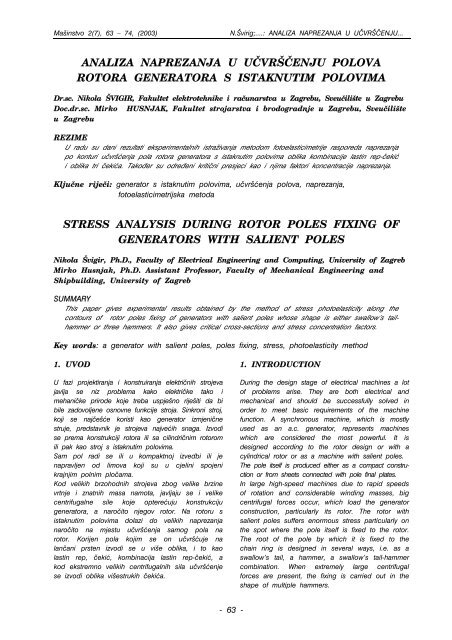
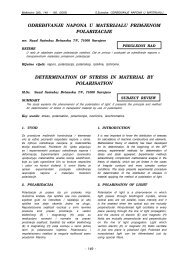
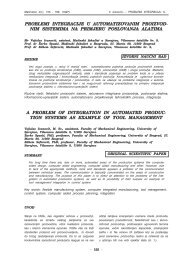

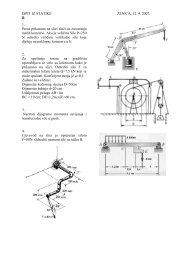
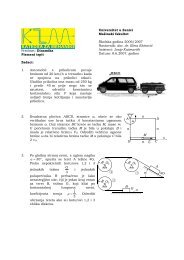
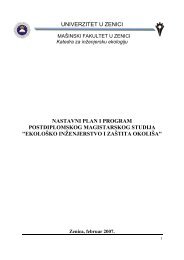
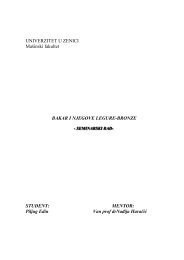
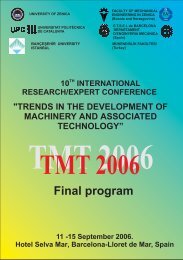
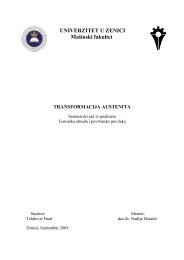
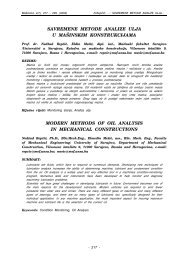
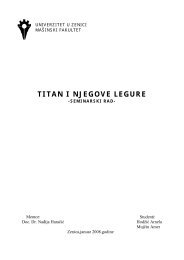
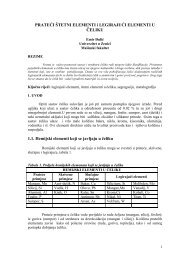
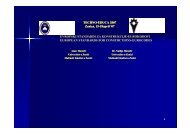
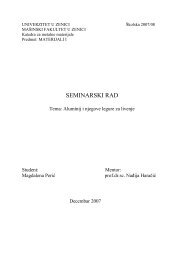
![zavarivanje kao metod produ@enja @ivotnog vijeka ku]i[ta toplotnih ...](https://img.yumpu.com/36506092/1/184x260/zavarivanje-kao-metod-produenja-ivotnog-vijeka-kuita-toplotnih-.jpg?quality=85)